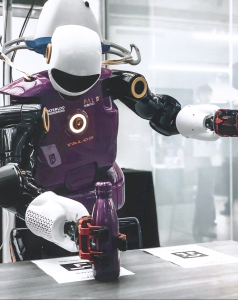PAL Robotics, the robotics system supplier of our newest humanoid TALOS, wrote a post on their blog interviewing our team members about the RoboHub and plans for our TALOS. Visit their website for the original article.
Last week, the University of Waterloo inaugurated the E7 Engineering building, which has an impressive RoboHub with a big family of robots… Amongst which, you can find TALOS! The 32-DoF humanoid robot has joined the RoboHub family, and showed its manipulation skills during the Grand Opening.We had the opportunity to speak with Professor Kulic and Professor Melek about their plans for TALOS at RoboHub, as well as with the RoboHub Manager, Brandon DeHart. Here are some of the questions they answered:
What is the goal of the Waterloo RoboHub?

This will be achieved in three ways: developing research leadership in robotics and intelligent systems; building capacity to enable researchers working on different areas of robotics to work in parallel; and establishing a unique facility to study the design and deployment of robots and robot teams across these and other application areas.”
How will TALOS contribute to the RoboHub?
“The TALOS will be one of our key experimental platforms supporting research in control and planning, industrial automation, and human-robot interaction. As the first platform of its kind in Canada, the TALOS is an excellent and agile platform for conducting groundbreaking research in human-robot interaction, advanced motion planning, and the integration of humanoid robots with other machines in human-centric environments.”
What kind of research will you conduct with TALOS?
“The TALOS will be used to experimentally validate both fundamental and applied research. Research programs to be supported by the TALOS include work on control and gait synthesis, grasp and bimanual manipulation planning, human-robot interaction, and machine learning. The robot’s agility and large number of degrees of freedom will also enable advanced research in modeling, motion planning, control and navigation of high DoF human-like robotic systems in semi-structured and unstructured environments.”
What aspects made you decide you wanted to have that humanoid platform at RoboHub?

Finally, which are the next steps needed to integrate robots into our lives, and how does RoboHub plan to contribute to that process?
“Augmenting robotic platforms (e.g., the wheeled, legged, flying, and magnetically levitated systems we have in the RoboHub) with advanced algorithms which incorporate machine learning and other AI methods for efficient situation awareness, assessment of human cognitive workload, understanding human intent and effective planning and control to work collaboratively in human-centric environments.
Also, using the above capabilities to enable humans to better understand robots behavior in order to gain more confidence in automation and the AI which powers these intelligent robotic systems. Thanks in part to TALOSand the other advanced systems we have here, the RoboHub has the capacity and the researchers here have the experience to make significant contributions to this entire technology chain.
Many thanks to the Professors and to the RoboHub Manager for sharing their plans for TALOS at the University of Waterloo. We look forward to seeing this humanoid robot in action at RoboHub! If you’d like to learn more about TALOS, find extended information here. You can also follow up the Waterloo RoboHub’s latest news on their amazing work through their webpage or by following their social networks (such as Twitter or Instagram)!